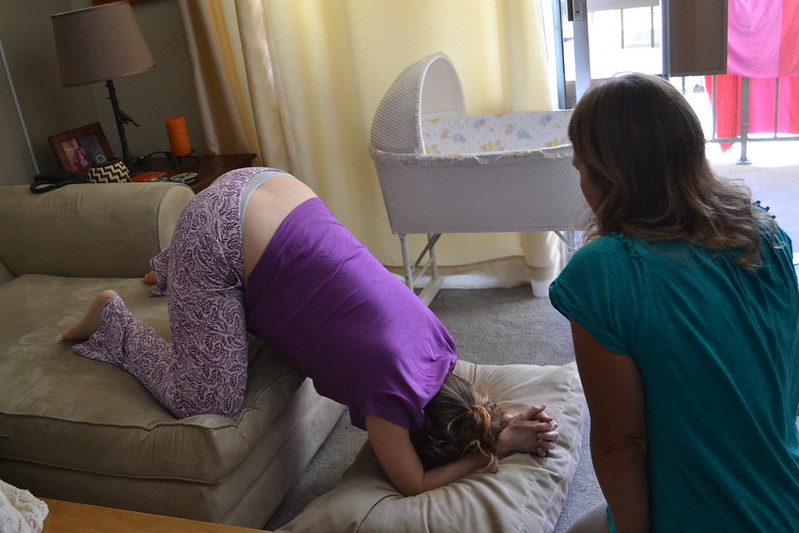Birth Stories
Before I got pregnant, I found birth stories boring. As far as I could tell, they could all be summed up as follows:
- The baby is inside.
- There is a lot of pain, and medical things happen.
- The baby is outside.
And while that sequence of events is generally correct, I now realize how widely it can vary in the specifics.
As my due date approached, I developed a huge appetite for birth stories. I started caring about details that had never seemed particularly important before. Was the mother induced, or was it a spontaneous delivery? Did she get the epidural or not? Continuous or intermittent fetal monitoring? Obstetrician or midwife? Vaginal birth or C-section?
I also started to appreciate my own choices. Without giving it much thought, the younger me assumed that I’d have a spontaneous, vaginal delivery. I’d ask the doctors to load me up with painkillers until I bled Tylenol.
But as my due date ticked closer, I realized that I couldn’t just assume that the birth would go the way I envisioned it. More disturbingly, I realized that I couldn’t necessarily assume that my medical team would choose the interventions that were best for me.
My history with back pain left me with trust issues where the medical establishment was concerned. I had gone through the ringer of back pain treatments, from injections, to medications, to physical therapy, to surgery, and all I had to show for it was a pile of insurance claims and a scar on my back.
This time, I did my research. I downloaded obstetrics and midwifery textbooks. I scoured PubMed for journal articles. I read, and re-read, Emily Oster’s Expecting Better. I learned the names of famous midwives and compared different birthing philosophies. I spent quite a bit of time perusing the articles on Evidence Based Birth. I even practiced hypnotherapy visualizations.
When it comes to giving birth, there are no options that are right for every woman, every time. In this article, I review the options I had, and explain what I chose, based on my own situation and needs. I am not trying to make universal recommendations, nor do I presume to judge women who choose differently.
In particular, I want to focus on issues that seemed relevant to my sitting disability. None of the midwives or doctors I saw during my pregnancy could offer much guidance on that subject. It was up to me to flag potential problem areas, and prepare as best I could.

Obstetrician or Midwife
The first choice I had to make, chronologically speaking, was whether to entrust my care to an obstetrician or a midwife. I chose my hospital’s midwife team for several reasons.
First, I technically had an uncomplicated pregnancy. For although I considered my sitting disability a complication, it wasn’t a studied complication, and therefore it didn’t count. Obstetrics is a surgical specialty, and I saw no reason to entrust my care to a surgeon if I didn’t have to. Give a surgeon a scalpel, and he might be tempted to use it.
Second, I was immediately struck by the difference in tone between the obstetrics and midwifery textbooks. The obstetrics textbooks referred to the mother not as a person, but as a collection of anatomical features that must be monitored and manipulated. Her thoughts and feelings, if they were mentioned at all, were treated as obstacles.
In contrast, the midwifery books devoted a significant portion of their wordcount to the mother’s experience. They talked about how women with a history of sexual trauma might react negatively to manual exams, and discussed how the midwife might make labor a more fulfilling emotional experience for the mother. (No screaming at her to PUSH!!!, for example.)
Through all this reading, I started to stereotype midwives as touchy-feely types who probably spent their time off participating in drum circles and writing poems about the cyclical nature of life. I stereotyped obstetricians as cold, clinical types who believed that emotional outbursts were best treated by an anesthesiologist. When it came to childbirth, I decided I preferred kooky to detached.
Epidurals
Before I knew anything about birth, getting an epidural seemed like an obvious choice. I wasn’t a fan of unnecessary pain, so why would I say no to a powerful and reliable pain reliever? But once I started looking into what an epidural involved, I started to question whether it was, in fact, the right choice for me.
I discovered that, for all its pain-relieving power, the epidural would severely curtail my freedom of movement. Though my particular capabilities would depend on the anesthesiologist’s specific technique and medication cocktail, there was a good chance that I would be bed-bound during labor.
Because my sciatic nerve had decided, midway through pregnancy, that it would not let me lay down on my back, I didn’t relish the idea of giving birth that way. No one could tell me for sure what effect the epidural would have on my sciatica, but there was no specific reason to think that it would prevent the intense Charley horses that resulted from my irritated nerve.
I envisioned a scenario in which I was stuck laboring on my back for hours, while simultaneously enduring the worst sciatica-induced leg cramps of my life. I would be trapped in a hospital room, completely dependent on hospital staff, unable to move, or walk, or get any real treatment for my cramps. Needless to say, I did not find this scenario appealing.
Accepting the epidural also meant I’d have a greater chance of accepting other interventions, from Pitocin to the dreaded C-section.
To be fair, not every woman dreads a C-section the way I did, and my resistance was largely emotional. I felt, fairly or not, that a C-section would be cheating me out of a chance to do an important job myself. In addition to my sciatica, I had dealt with fertility issues, and I wanted to give my body a chance to work properly for a change.
Although I certainly understood the appeal of an epidural, and did not completely discount it as an option, I decided to try for an unmedicated childbirth.

Photo courtesy of Wendy Kenin via Flickr.
Labor Positions
Based on a lifetime of TV consumption, I had assumed that the only real way to go about labor was by lying on your back while the doctor yelled at you to push. However, I found it heartening to know lying down during birth is certainly not necessary, and may not even be preferable. I learned that lying in bed only became the default position in modern times, after birth became a medical event and anesthesia became widely available.
No source I consulted claimed that the bed-bound position was best for a laboring woman. Instead, it seemed to be a convenience adopted for the sake of the doctors and nurses who are swarming around the woman and “helping.”
(For those interested, the Evidence Based Birth website has an excellent write-up on birthing positions.)
Upright positions, such as squatting, kneeling, or sitting on a birth stool, are actually preferred by many practitioners who are either super-traditional (midwives), or super-progressive (certified midwives). The purported benefits include shorter labors, better oxygen supply to the baby, and lower chances of an instrument-assisted delivery. Plus, it’s supposed to feel better.
Since I mostly managed my sciatica through exercise rather than medications, the idea of moving around and using different postures to manage labor pain seemed natural. And since my pain-free positions were so limited, I wanted to be sure I could always get back into one of them.
I studied the illustrations in several books and articles, and made note of the positions that looked most comfortable to me. I wanted to be prepared to try them during my actual labor.

Photo courtesy of Plastik und Medizin / von Eugen Holländer via the Wellcome Collection.
Modern or Natural
There seems to be a sharp divide in birthing philosophies between modern (doctor knows best, now give me meds), and natural (women were designed to give birth, the less interference the better).
I surprised myself when I realized I was siding more and more with Camp Natural. It had always seemed a bit too hippy-dippy for me, but now I realized how important autonomy was to me, and how a natural childbirth could facilitate that.
When I wrote a birth plan, I basically specified that I wanted as few interventions as possible, and only when absolutely necessary.
But best laid plans and all that. As much as I wanted to go the natural route – spontaneous labor, no meds – I lost that battle before my labor even started. First, I tested positive for Group B Strep, which meant I was getting antibiotics during labor. (Technically, I still had the right to refuse, but in this case, I couldn’t argue with the data.)
And then, there was the issue of an induction.
Induction
As my November 24th due date came and went, both my midwives and I grew increasingly uncomfortable with my pregnancy, albeit for different reasons. I was tired of carrying a bowling ball in my stomach at all times, especially since it had a tendency to randomly drop on my bladder.
I was also getting impatient to meet this tiny creature. As long as she remained a black-and-white ultrasound image, she felt more like an abstract concept than a real person.
My midwives started to worry about medical complications, such as a deteriorating placenta, or the increased risk of stillbirth. (When I looked into the evidence, I decided that the data showing an increased risk after 42 weeks was suggestive, but not conclusive.) I started going in for regular ultrasounds and non-stress tests, in which the baby’s heart rate was monitored.
At 41 weeks, none of the tests showed any cause for concern, so I was less worried about the baby than about the hospital’s policy on post-term births. If I went into labor after 42 weeks, the midwives would not be allowed to oversee my care. Instead, I would be passed to an obstetrician.
It had taken me months to build up trust in the midwives. The thought of being passed to a doctor who I had never met, and who knew nothing about my case other than that it was high risk, filled me with dread.
Feeling more than a little coerced, I agreed to schedule an induction for Monday, December 6th, which would put me at 41 weeks and 5 days.
No one said inductions were fun, but I admit I blew any potential downsides out of proportion. I was afraid that I wouldn’t be able to relax in a hospital room full of people in scrubs, and my body would sabotage the birth. I was convinced that labor pains from Pitocin would be far worse than anything my own hormones would subject me to. I assumed that by accepting one medical intervention, I was in fact agreeing to a cascade of subsequent interventions. I started having nightmares about forced C-sections.
I prayed for a natural labor. I started using my breast pump regularly, in the hopes that it would hasten my child’s arrival.
Alas, none of it worked, and so I had no choice but to show up at the birthing center at 11 a.m., as planned.
The hospital’s birthing center was where “in theory” met “in fact.” And there I discovered the truth of the old adage, “Plans are useless, but planning is indispensable.”

One thought on “I Have Chronic Sciatica and a Sitting Disability. Here’s How I Prepared for Childbirth.”